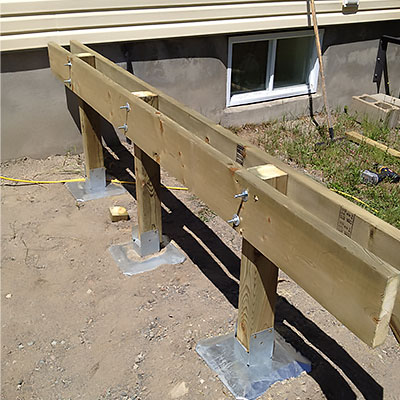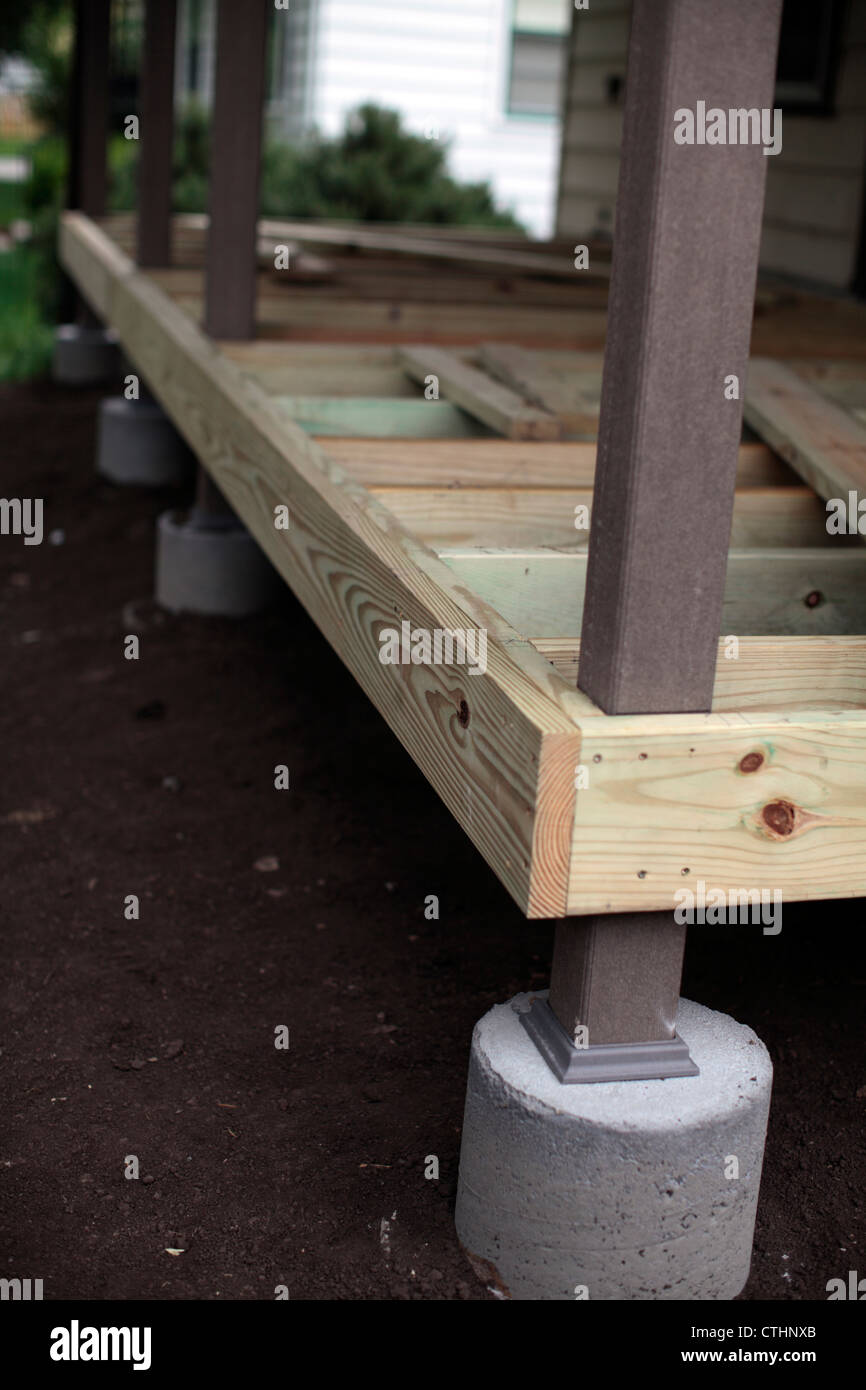Optimize the Life Expectancy of Your Deck With Solid and reliable Footings
In order to completely maximize the life expectancy of your deck, it is important to guarantee that it is built on reliable and solid footings. These footings form the structure of your deck, providing stability and support, and are commonly the difference between a deck that lasts for decades and one that calls for constant repair work. In this discussion, we will explore the importance of reputable footings, the different kinds of solid ground materials, correct installation techniques, and just how to maintain and check your deck's grounds to avoid damages.
Value of Trusted Grounds
The value of reliable grounds can not be overemphasized when it concerns making the most of the life-span of your deck. The footings act as the structure whereupon the whole structure rests, supplying stability and assistance. Without a solid ground, the deck is susceptible to moving, sinking, and also collapse, which can significantly reduce its lifespan and posture safety and security threats.

Selecting the right sort of ground is additionally essential. One of the most usual types include concrete grounds, helical piers, and sonotubes. Factors such as soil conditions, climate, and the dimension of the deck will establish the most appropriate choice. Hiring a specialist to assess the dirt, style the footings, and guarantee correct setup is very recommended.
Purchasing trustworthy footings may entail added price and initiative upfront, however it is a worthwhile financial investment that will certainly add to the long-term toughness and safety and security of your deck. By ensuring a solid structure, you can appreciate your deck for years to find, knowing that it is developed to hold up against the test of time.
Kinds of Solid Footing Products
To ensure the stability and long life of your deck, it is important to consider the various kinds of solid ground materials readily available. The selection of footing material is critical as it gives the required support and security to endure the weight and lots of the deck framework.
One trustworthy and typical material utilized for deck footings is concrete. Concrete grounds are sturdy and give superb stability. They can be put straight into the ground or make use of precast concrete grounds for easier setup. Another option is helical piers, which are steel shafts with helical plates that are screwed into the ground. These piers use outstanding load-bearing capability and can be made use of in various dirt conditions.
For areas with poor soil conditions, such as expansive or loose dirts, a ground system that utilizes steel or composite piers may be liked. Deck Footings. These piers are driven deep right into the ground to reach steady dirt layers, making certain the security of the deck
In some cases, deck footings can likewise be constructed using cured lumber. Nonetheless, it is necessary to ensure that the lumber is correctly treated to stand up to rot and decay triggered by direct exposure to wetness and insects.
When selecting a ground product for your deck, it is essential to take into consideration aspects such as soil problems, environment, and regional building codes. Consulting with a professional service provider or structural designer can assist determine the most appropriate ground material for your particular deck project.
Correct Setup Methods for Grounds
Taking into consideration the significance of ensuring stability and toughness for your deck, it is essential to comprehend the appropriate installation strategies for grounds. The success of your deck project counts greatly on the stability of its foundation, which is why adhering to the proper installment strategies is critical.
First and leading, it is necessary to establish the ideal dimension and deepness of the footings based on the layout and lots requirements of your deck. This information can be obtained from constructing codes or through examination with a structural engineer. As a basic regulation, footings ought to be at the very least 12 inches in diameter and expand listed below the frost line to protect against shifting or clearing up.
When the dimensions are developed, the following step is excavation. Digging the openings for the grounds must be finished with accuracy, ensuring they are deep adequate and have a level bottom. Deck Footings. This will offer a steady base for the footings
To further improve the stability of the footings, it is suggested to use a concrete combine with a strength of at least 3,000 psi. This will certainly make certain the footings can stand up to the weight and forces applied by the deck.
Throughout installation, it is very important to keep the footings degree and aligned appropriately. This can be attained by utilizing a level and string lines to direct the placement of each footing.
Maintaining and Examining Your Deck's Footings
Normal upkeep and extensive assessments are essential for making certain the long-term stability and safety and security of your deck's footings. Over time, footings can catch tear and wear, climate condition, and soil activity, which can compromise their architectural honesty. To make best use of the life-span of your deck's grounds, it is important to execute a normal upkeep routine and perform detailed inspections.

Additionally, it browse this site is critical to examine grounds for any type of indicators of damage or damage. This consists of monitoring for cracks, divides, or crumbling concrete, as well as any type of signs of motion or settlement. Any issues should be attended to quickly to prevent more damage and make sure the security of the deck.
Furthermore, it is advised to evaluate the surrounding dirt for any kind of indicators of erosion or moving. Soil motion can affect the security of the footings, so it is very important to attend to any kind of soil-related issues promptly.
Indications of Footing Damage and Exactly How to Address Them
Footing damage can pose significant threats to the stability and security of your deck, making it necessary to immediately determine and address any indications of damage. Among the most typical indications of footing damages is sinking or settling of the deck. This can take place due to dirt erosion, poor footings, or poor building and construction methods. If you see that your deck is uneven or leaning, it is critical to take prompt action to avoid further damages. Another indicator of footing damage is falling apart or splitting of the concrete grounds. This can be triggered by freeze-thaw cycles, extreme moisture, or bad top quality concrete. It is essential to have them examined and repaired by a specialist if you observe any kind of splits or degeneration in the grounds. Additionally, if you notice any type of movement or changing of the deck, such as a deck that feels unsteady when strolled on or wobbles when weight is applied, maybe a sign of footing damages. In such instances, it is recommended to talk to an expert contractor or a structural designer to analyze the degree of the damages and figure out the ideal strategy. Bear in mind, attending to footing damage quickly can aid make sure the long-term stability and security of your deck.
Final Thought
In final thought, ensuring the integrity and stamina of footings is crucial for maximizing the lifespan of your deck. By making use of solid footing materials and appropriately mounting them, you can prevent damage and keep the stability of your deck.
These footings form the structure of your deck, supplying stability and support, and are typically the difference in between a deck that lasts for years and one that needs consistent fixings. In this discussion, we will discover the value of reputable footings, the different types of solid footing materials, appropriate setup strategies, and how to preserve and check your deck's footings to avoid damages.Normal upkeep and article comprehensive evaluations are vital for ensuring the long-term security and safety of your deck's grounds. Bear in mind, dealing with footing damages promptly can aid make certain the long-term security and safety of look what i found your deck.
By using strong ground materials and effectively mounting them, you can prevent damage and keep the stability of your deck.